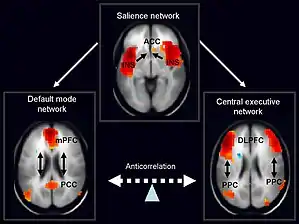Frontoparietal network
The frontoparietal network (FPN), generally also known as the central executive network (CEN) (see Nomenclature), is a large-scale brain network primarily composed of the dorsolateral prefrontal cortex and posterior parietal cortex,[4] around the intraparietal sulcus.[5] It is involved in sustained attention, complex problem-solving and working memory.[1]

The FPN is one of three networks in the so-called triple-network model, along with the salience network and the default mode network (DMN).[6] The salience network facilitates switching between the FPN and DMN.[1][2]
Anatomy
The FPN is primarily composed of the rostral lateral and dorsolateral prefrontal cortex (especially the middle frontal gyrus) and the anterior inferior parietal lobule. Additional regions include the middle cingulate gyrus and potentially the dorsal precuneus, posterior inferior temporal lobe, dorsomedial thalamus and the head of the caudate nucleus.[7]
Function
The FPN is involved in executive function and goal-oriented, cognitively demanding tasks.[7] It is crucial for rule-based problem solving, actively maintaining and manipulating information in working memory and making decisions in the context of goal-directed behaviour.[1]
Clinical significance
Disruption of the nodes of the FPN has been found in virtually every psychiatric and neurological disorder, from autism, schizophrenia and depression to frontotemporal dementia and Alzheimer's disease.[1]
Nomenclature
The term central executive network (CEN) is generally equivalent to the frontoparietal network in literature,[8][9][10] distinguishing it from the dorsal attention network (DAN), with which it has several similarities,[5] though sometimes it has been used to include the DAN.[10]
The FPN has fewer similarities with the salience network (which has also been equated with the cingulo-opercular network or ventral attention network[7]). Regardless, it has sometimes been grouped together with either the DAN or the salience network (usually the latter[11]) under the name executive control network (ECN).[5] The term frontoparietal control network (FPCN) has also been used, generally also for a grouping of the FPN and the salience network.[5][11]
Other names for the FPN have included the multiple-demand system, extrinsic mode network, domain-general system and cognitive control network.[7]
In 2019, Uddin et al. proposed that lateral frontoparietal network (L-FPN) be used as a standard name for this network.[7]
See also
References
- Menon, Vinod (1 October 2011). "Large-scale brain networks and psychopathology: a unifying triple network model". Trends in Cognitive Sciences. 15 (10): 483–506. doi:10.1016/j.tics.2011.08.003. ISSN 1364-6613. PMID 21908230.
- Sridharan, D.; Levitin, D. J.; Menon, V. (22 August 2008). "A critical role for the right fronto-insular cortex in switching between central-executive and default-mode networks". Proceedings of the National Academy of Sciences. 105 (34): 12569–12574. Bibcode:2008PNAS..10512569S. doi:10.1073/pnas.0800005105. PMC 2527952. PMID 18723676.
- Nekovarova, Tereza; Fajnerova, Iveta; Horacek, Jiri; Spaniel, Filip (30 May 2014). "Bridging disparate symptoms of schizophrenia: a triple network dysfunction theory". Frontiers in Behavioral Neuroscience. 8: 171. doi:10.3389/fnbeh.2014.00171. PMC 4038855. PMID 24910597.
- Gong, Diankun; He, Hui; Ma, Weiyi; Liu, Dongbo; Huang, Mengting; Dong, Li; Gong, Jinnan; Li, Jianfu; Luo, Cheng (14 January 2016). "Functional Integration between Salience and Central Executive Networks: A Role for Action Video Game Experience". Neural Plasticity. Retrieved 28 June 2020.
- Gratton, Caterina; Sun, Haoxin; Petersen, Steven E. (2018). "Control networks and hubs". Psychophysiology. 55 (3): e13032. doi:10.1111/psyp.13032. ISSN 1469-8986. PMC 5811327. PMID 29193146.
- van Oort, J.; Tendolkar, I.; Hermans, E. J.; Mulders, P. C.; Beckmann, C. F.; Schene, A. H.; Fernández, G.; van Eijndhoven, P. F. (1 December 2017). "How the brain connects in response to acute stress: A review at the human brain systems level". Neuroscience & Biobehavioral Reviews. 83: 281–297. doi:10.1016/j.neubiorev.2017.10.015. ISSN 0149-7634. PMID 29074385. S2CID 35066027.
- Uddin, Lucina Q.; Yeo, B. T. Thomas; Spreng, R. Nathan (1 November 2019). "Towards a Universal Taxonomy of Macro-scale Functional Human Brain Networks". Brain Topography. 32 (6): 926–942. doi:10.1007/s10548-019-00744-6. ISSN 1573-6792. PMC 7325607. PMID 31707621.
- Philippi, Carissa L.; Pujara, Maia S.; Motzkin, Julian C.; Newman, Joseph; Kiehl, Kent A.; Koenigs, Michael (15 April 2015). "Altered Resting-State Functional Connectivity in Cortical Networks in Psychopathy". Journal of Neuroscience. 35 (15): 6068–6078. doi:10.1523/JNEUROSCI.5010-14.2015. ISSN 0270-6474. PMC 4397604. PMID 25878280.
- Brodal, Per (2016). The Central Nervous System. Oxford University Press. p. 578. ISBN 978-0-19-022895-8.
- Littow, Harri; Huossa, Ville; Karjalainen, Sami; Jääskeläinen, Erika; Haapea, Marianne; Miettunen, Jouko; Tervonen, Osmo; Isohanni, Matti; Nikkinen, Juha; Veijola, Juha; Murray, Graham (2015). "Aberrant Functional Connectivity in the Default Mode and Central Executive Networks in Subjects with Schizophrenia – A Whole-Brain Resting-State ICA Study". Frontiers in Psychiatry. 6. doi:10.3389/fpsyt.2015.00026. ISSN 1664-0640. PMID 25767449. S2CID 14879568.
- Spreng, R. Nathan; Sepulcre, Jorge; Turner, Gary R.; Stevens, W. Dale; Schacter, Daniel L. (January 2013). "Intrinsic architecture underlying the relations among the default, dorsal attention, and frontoparietal control networks of the human brain". Journal of Cognitive Neuroscience. 25 (1): 74–86. doi:10.1162/jocn_a_00281. ISSN 0898-929X. PMC 3816715. PMID 22905821.